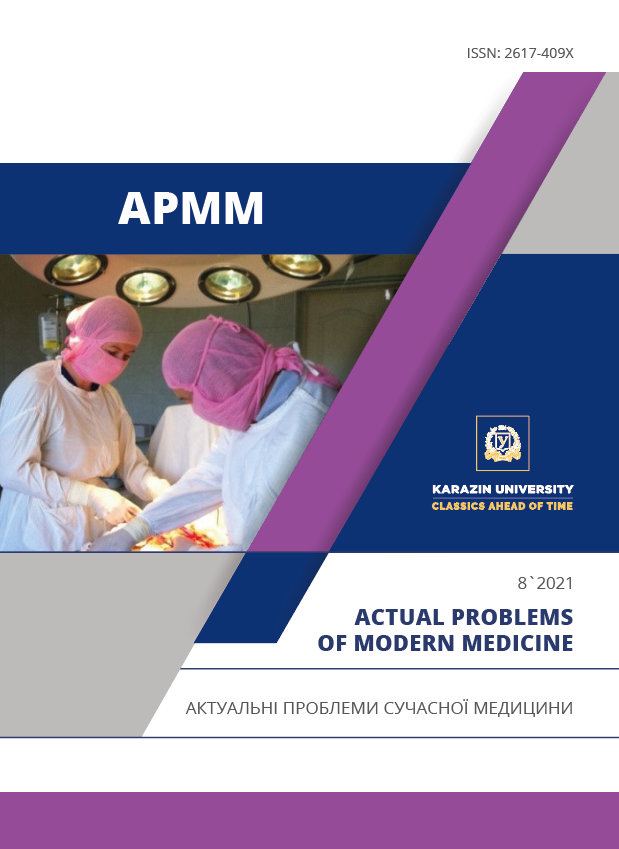Hepatomegaly syndrome in mucopolysaccharidosis and type in children of ukraine: features of clinical characteristics
Abstract
Summary. The article is devoted to a topical issue in pediatrics - hepatomegaly syndrome in a rare metabolic pathology - mucopolysaccharidosis type I.
Goal. To study the possibilities of early diagnosis of hepatomegaly syndrome as one of the most important clinical manifestations of type I MPS and to determine early diagnostic criteria for the course of the disease.
Materials and methods. Retrospective clinical study of 24 children with type I mucopolysaccharidosis who were diagnosed in Ukraine for 17 years (from 2004 to 2021). Patients underwent a complete comprehensive examination of the manifestations of the disease and determined the activity of the enzyme a-L-iduronidase in the lysosomes of leukocytes using a biochemical method, the study of the level of excretion of glycosaminoglycans in the urine.
Results. Clinical symptoms and examination results in 24 children diagnosed with type I mucopolysaccharidosis in Ukraine were analyzed. The conducted comprehensive examination revealed a significant frequency of hepatomegaly syndrome among patients of this study. Its combination with other clinical symptoms. Hepatomegaly syndrome in children was found in 79 %, which was combined with other clinical symptoms of mucopolysaccharidosis, but never was the cause of the initial examination of the patient and the key symptom. Hepatomegaly was most often observed in the symptom complex with contractures and stiffness of the joints, curvature of the spine, lesions of the valvular apparatus of the heart and umbilical hernias. In contrast to the previously described studies, only 20% of hepatomegaly syndrome was combined with splenomegaly. Biochemical studies did not reveal liver dysfunction. There was also a direct relationship between the degree of hepatomegaly and the severity of glycosaminoglycan secretion.
Conclusions. Liver enlargement syndrome in many childhood diseases, including orphan metabolic diseases, remains an underestimated diagnostic criterion. Detection of hepatomegaly syndrome can direct the diagnostic search of the practitioner to exclude hereditary metabolic disorders, including mucopolysaccharidosis. Early detection of such a complex and severe disease in children as mucopolysaccharidosis type I will allow to start treatment in time and prevent disability and early death.
Downloads
References
Kotovich MM, Manerov FK, Luchsheva EV. Nosological aspects of hepatomegaly and splenomegaly at pediatric age. Russian Journal of Gastroenterology, Hepatology, Coloproctology. 2016;26(1):54-58. [In Russian]. DOI: https://doi.org/10.22416/1382-4376-2016-26-1-54-58.
Wolf AD, & Lavine JE. Hepatomegaly in Neonates and Children. Pediatrics in Review. 2000;21(9):303–310. DOI: https://doi.org/10.1542/pir.21-9-303.
Taylor KR, Gallo RL. Glycosaminoglycans and Their Proteoglycans: Host-associated Molecular Patterns for Initiation and Modulation of Inflammation. FASEB J. 2006;20:9–22. DOI: https://doi.org/10.1096/fj.05-4682rev.
Khan SA, Peracha H, Ballhausen D, Wiesbauer A, Gautschi M, Mason RW, Giugliani R, Suzuki Y, Orii KE, Orii T, et al. Epidemiology of Mucopolisaccharidoses. Mol. Genet. Metab. 2018;121:227–240. DOI: https://doi.org/10.1016/j.ymgme.2017.05.01.
Kubaski F, De Oliveira Poswar F, Michelin-Tirelli K, Burin MG, Rojas-Málaga D, Brusius-Facchin AC, Leistner-Segal S,Giugliani, R. Diagnosis of Mucopolysaccharidoses. Diagnostics 2020;10:172. DOI: https://doi.org/10.3390/diagnostics10030172.
Celik B, Tomatsu SC, Tomatsu S, Khan SA. Epidemiology of Mucopolysaccharidoses Update. Diagnostics 2021;11:273. DOI: https://doi.org/10.3390/diagnostics11020273.
Neufeld EF, Muenzer J: The mucopolysaccharidoses. In The Online Metabolic and Molecular Bases of Inherited Disease. Volume chapter 136. Edited by: Valle D, Beaudet AL, Vogelstein B, Kinzler KW, Antonarakis SE, Ballabio A. New York: McGraw-Hill; 2007. DOI: 10.1036/ommbid.165.
Murphy AM, Lambert D, Treacy EP, O’Meara A, Lynch SA: Incidence and prevalence of MPS I in the Irish Republic. Arch Dis Child 2009, 94:52-54. DOI: https://doi.org/10.1136/adc.2007.135772.
Pichkur NO, Olkhovych NV, Gorovenko NG. Lysosomal diseases of accumulation in Ukraine. Bulletin of problems biology and medicine. 2017;4(2):14-19. Access mode: http://nbuv.gov.ua/UJRN/Vpbm_2017_4(2)__4. [Ukrainian].
Terlato NJ, Cox GF: Can mucopolysaccharidosis type I disease severity be predicted on a patient’s genotype? A comprehensive review of the literature. Genet Med 2003;5:286-294. DOI: https://doi.org/10.1097/01.GIM.0000078027.83236.49.
Cheema HA, Malik HS, Hashmi MA, Fayyaz Z, Mushtaq I, Shahzadi N. Mucopolysaccharidoses—Clinical Spectrum and Frequency of Different Types. J. Coll. Physicians Surg. 2017;27:80–83. https://www.researchgate.net/publication/316629649_Mucopolysaccharidoses_-_Clinical_Spectrum_and_Frequency_of_Different_Types.
Muenzer J, Wraith JE, Clarke LA, International Consensus Panel on Management and Treatment of Mucopolysaccharidosis I: Mucopolysaccharidosis I: management and treatment guidelines. Pediatrics. 2009;123:19-29. DOI: https://doi.org/10.1542/peds.2008-0416.
Kimberly M, Ross E. Petty, Musculoskeletal manifestations of mucopolysaccharidoses, Rheumatology, Volume 50, Issue suppl_5, 1 December 2011. P. 19-25. https://academic.oup.com/rheumatology/article/50/suppl_5/v19/1780256.
Federhen A, Pasqualim G, de Freitas TF, Gonzalez EA, Trapp F, Matte U, Giugliani R. Estimated Birth Prevalence of Mucopolysaccharidoses in Brazil. Am. J. Med. Genet. Part A. 2019;182:469–483. DOI: https://doi.org/10.1002/ajmg.a.61456.
Stapleton M, Arunkumar N, Kubaski F, Mason RW, Tadao O. Tomatsu S. Clinical Presentation and Diagnosis of Mucopolysaccharidoses. Mol. Genet. Metab. 2018;125:4–17. DOI: https://doi.org/10.1016/j.ymgme.2018.01.003.
Vairo F, Federhen A, Baldo G, Riegel M, Burin M, Leistner-Segal S, Giugliani R. Diagnostic and Treatment Strategies in Mucopolysaccharidosis VI. Appl. Clin. Genet. 2015;8:245–255. DOI: https://doi.org/10.2147/TACG.S68650.
Sawamoto K, Stapleton M, Alméciga-Díaz CJ, Espejo-Mojica AJ, Losada JC. Suarez DA. Tomatsu S. Therapeutic Options for Mucopolysaccharidoses: Current and Emerging Treatments; Springer International Publishing: Berlin/Heidelberg, Germany. 2019;79, ISBN 4026501901147. DOI: https://doi.org/10.1007/s40265-019-01147-4.
Trofimova NS. Molecular-genetic characterisation of Ukrainian patients with mucopolysaccharidosis I: identification of three new mutations in -L-iduronidase gene, Biopolymers and Cell. 2016. DOI: https://doi.org/10.7124/bc.00093B




